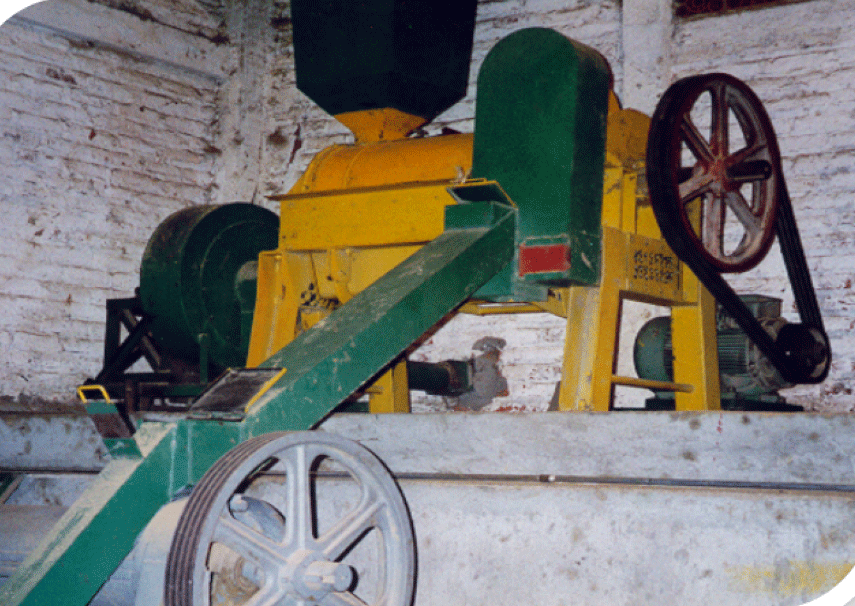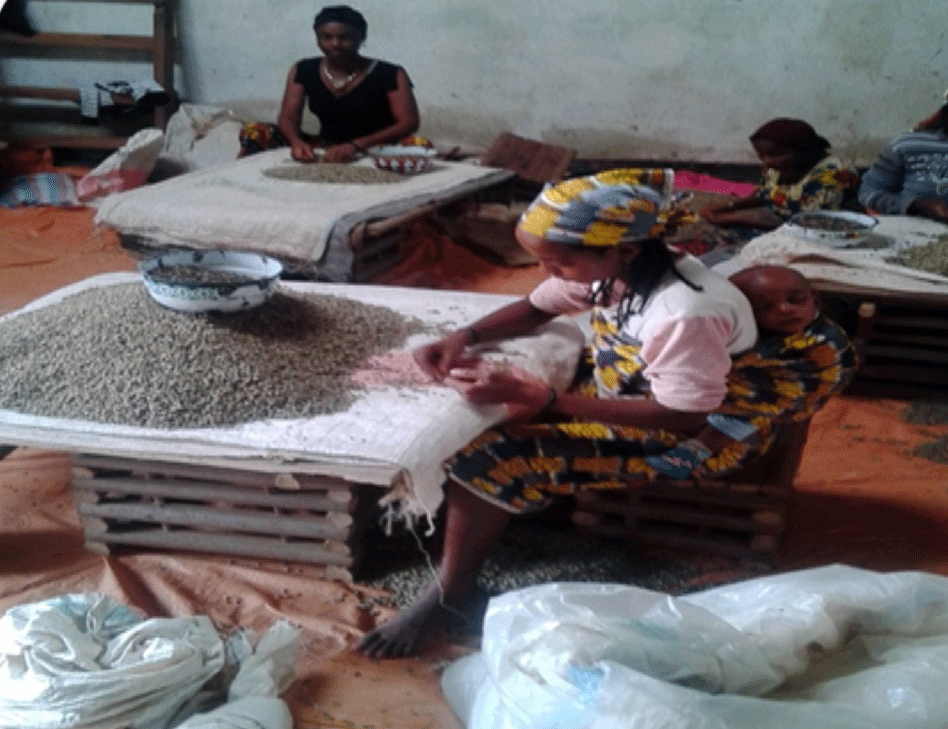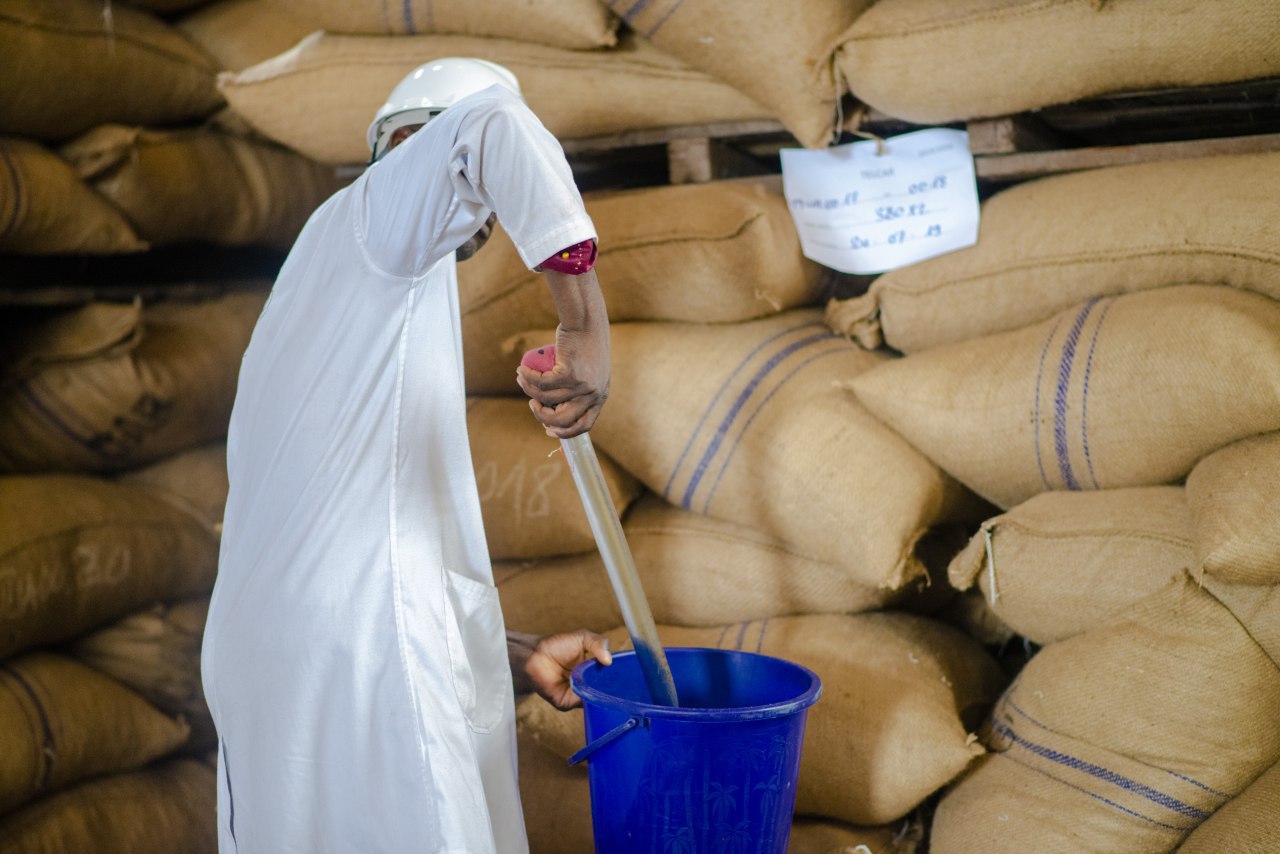Third Stage: Processing
The actual processing comprises three operations: reception of the raw coffee, hulling and sorting.
1. Receiving bulk coffee
WHAT TO DO
All coffee from the first stage plants must be received in accordance with the protocol below:
- Cargo weighing;
- Sampling by bag;
- Determination of moisture content, which must be less than 12%;
- Analysis of total defects;
- Determination of foreign matter content;
- Mini-calibration (prediction of the particle size distribution/grade of the batch after machining);
- Drawing up an acceptance sheet.
If the cargo is accepted, it must undergo pre-cleaning, followed by catadorage (operations that remove all twine, broken coffee, parchment and hulls, wood and other foreign matter from the coffee).
WHAT NOT TO DO
- accept and grade a batch of coffee with a moisture content of over 12%; this practice distorts the granulometry of the coffee after drying;
- rejecting parchment, dust, hull debris and light broken coffee into the atmosphere, "using a cyclone at the catador outlet";
- mix different grades or types of coffee with different levels of humidity in the same bay.
2. Hulling coffee in the shell or parchment leads to green coffee.
WHAT TO DO
- before hulling or dehulling, pass the coffee hull or parchment through a pre-cleaner to separate impurities finer or coarser than the product (through sieves);
- remove dust and the lightest waste (through a counter-current air flow) and remove metal parts (by trapping them with a magnet);
- next, the stones of the same size as the product are separated using a density separator;
- At the end of the process, the green coffee is separated from the hull or parchment by a counter-current flow of air.
- Additional polishing removes the silver film and gives the green coffee a more attractive appearance, with the colour changing to a pleasant blue-green.
WHAT NOT TO DO
- adjusting the cutter too tightly;
- the introduction of wet coffee into the polisher.
WHAT WE RISK:
- if the knife is set too tightly, there will be a high percentage of broken kernels
- excessive moisture in the product results in a high percentage of flattened beans or broken beans;
- the damp product heats up in the drum, giving the cup a metallic taste.

Decorticator (Engelberg type) 1
3. Sorting
Taken in the broadest sense of the word, coffee sorting covers all the processing operations that involve separating coffee beans by:
- granulometry (grading)
- densimetry (sorting by grade and identical density);
- total defects (manual and colorimetric sorting);
- by weight and foreign matter (de-stoning).
The raw material from the first stage plant contains defects that must be eliminated, in particular stones, string and metal fragments.
The coffee is graded in the second and third-grade factories.
Calibration
The green coffee is sorted by grain size using rotating cylindrical sieves or oscillating flat sieves.
The sieves are fitted with round holes depending on whether the coffee is Robusta or Arabica.
This grading is justified for various reasons:
- Subsequent sorting (densimetric or colorimetric) is more effective;
- The proportion of defective grains is higher in the lower screens;
- Higher grades are better paid for;
- Roasting is more homogeneous for coffee of the same grain size.
Grading is a very delicate operation; the flow of coffee arriving in the grader must be
WHAT TO DO
- Receive graded coffee by grade and by silo;
- pass the large beans, grade I and possibly grade II on a rebound table, when electronic sorting is envisaged.
- check to prevent the coffee from jamming and the lower-grade beans from being retained in the upper screens.
- recycle the cherries (large Michel or elephant) for separate redecorticising.
i. Triage densimétrique
Graded coffee contains many defective beans, in particular light beans such as pitted beans, spongy beans, broken beans and shells. This category of beans, when not separated on the basis of their density, will burn before the roasting process is complete.
Classification by density is carried out using catadors and densimetric tables.
ii. Electronic sorting
After granulometric and densimetric sorting, it is possible to carry out electronic sorting in 3rd degree factories, which have electronic sorting machines to separate darker or lighter beans from healthy reference beans.
For Arabica coffee, there are also colorimetric sorters that separate stinky beans by fluorescence under ultraviolet light.
iii. Manual sorting
This operation is the most important stage in the preparation of quality coffee and remains by far the best method of producing good quality coffee.
Hand sorting has the advantage of separating unwanted beans, cherries, black beans, sour beans and foreign matter that electronic sorters cannot detect.

Hand sorting of green coffee
Hulling coffee in the shell or parchment leads to green coffee.
WHAT TO DO:
- before hulling or dehulling, pass the coffee hull or parchment through a pre-cleaner to separate impurities finer or coarser than the product (through sieves);
- remove dust and the lightest waste (through a counter-current air flow) and remove metal parts (by trapping them with a magnet);
- next, the stones of the same size as the product are separated using a density separator;
- At the end of the process, the green coffee is separated from the hull or parchment by a counter-current flow of air;
- additional polishing removes the silver film and gives the green coffee a more attractive appearance, with the colour changing to a pleasant blue-green.
WHAT NOT TO DO:
- adjusting the cutter too tightly;
- the introduction of wet coffee into the polisher.
WHAT WE RISK:
- if the knife is set too tightly, there will be a high percentage of broken kernels
- excessive moisture in the product results in a high percentage of flattened beans or broken beans;
- the damp product heats up in the drum, giving the cup a metallic taste.


